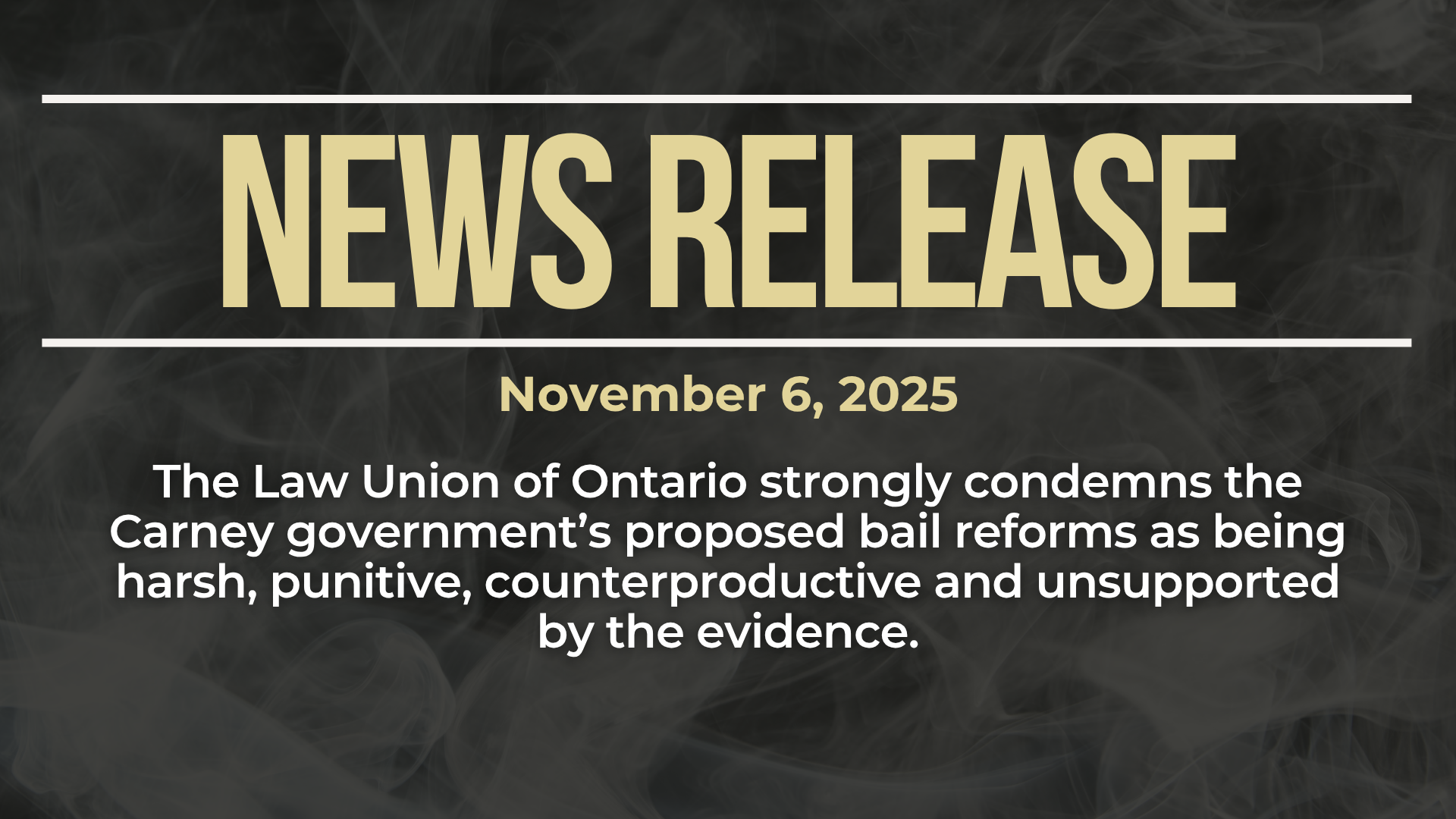Law Union of Ontario
Policing Subcommittee
IMMEDIATE RELEASE
The Law Union of Ontario strongly condemns the Carney government’s proposed bail reforms as being harsh, punitive, counterproductive and unsupported by the evidence.
The Law Union of Ontario strongly condemns the changes to our bail system proposed by the Carney government in Bill C-14, introduced on October 23, 2025.
Howard Morton, QC, Chair of the Law Union of Ontario’s Policing Committee, said, “This bill will not reduce crime. It will simply serve to create more hardship and injustice for those members of our society who are poor, suffer from mental health or drug problems, or belong to Indigenous, racialized or other disadvantaged and marginalized groups. Politicians, the media, and police services must be truthful about the indisputable fact that crime has been steadily declining since the last time we won the World Series. They must also be truthful and act on the root causes of crime which lie in chronic poverty, lack of opportunities for our youth, and systemic discrimination. Lasting public safety will only come if we marshal our resources to deal with the issues and not through ill-considered legislation like this.”
In the Law Union’s view, Bill C-14 as currently drafted will exacerbate an already dysfunctional bail system, add to the overcrowding and inhumane conditions in Ontario’s remand centres, create more hardship for the poor and racialized and Indigenous minorities who disproportionately fill our jails, and increase the likelihood of unjust convictions without in any way materially enhancing public safety, reducing crime, improving policing or addressing the underlying causes of crime.
The proposed changes will also violate our constitutional right not to be denied reasonable bail without just cause by adding to the ever-expanding list of offences for which an accused person must show cause why they should not be denied bail[1] and by requiring them to clearly demonstrate how their release will not risk public safety or public confidence in the administration of justice,[2] a virtually insurmountable burden for the poor, the homeless and the racialized members of our society who disproportionately end up in our bail courts and remand centres.
The changes are not evidence-based and are contrary to the numerous reports, studies and statistics over the past twenty years showing an unacceptable and unwarranted increase in the numbers of accused being detained and held in remand centres awaiting trial and the disproportionate effect of our bail system on the poor and on racial minorities.[3] Rather than aiming to solve these problems, Bill C-14 will only make them worse.
These changes are driven by political expediency and an appeal to public perception – itself a product of cynical politicking, police press releases and media attention – rather than reality. The Justice Minister Sean Fraser fed these misperceptions when he told reporters “I remember the last time the (Blue) Jays were in the World Series [1993], I was a kid who was playing ball hockey and riding bikes with my friends until we lost daylight. We never worried about our safety, and neither did our parents.” Despite the Minister’s undoubtedly sincere and fond memories of his childhood, the reality is that Canada’s crime rate peaked in 1995, a time of widespread public concerns about crime and safety, and has been on a steady decline ever since.[4] The evidence shows that things have gotten objectively safer.
The Ontario government statistics paint a grim picture of how bad the current bail system is.
- The average wait for a bail hearing has risen from 4.1 days in 2015 to 6.9 in 2024, a 68% increase.[5] The Toronto Regional Bail Centre set up to provide a centralized bail court for Toronto is widely acknowledged to be dysfunctional with people waiting for days for their bail hearings because no court is available.[6]
- The proportion of accused awaiting trial in our remand centres is over 70%.[7] Overcrowding is the norm with triple- and quadruple-bunking in cells built for at most two, inmates sleeping on the floors in common areas, and repeated lockdowns due to staffing shortages, denying inmates access to fresh air, showers and programs.
The denial of bail reverses the presumption of innocence, incentivizes pleas of guilty just to get out of jail, makes it more difficult for lawyers to access their clients, and increases the likelihood of unjust convictions. As Justice Iacobucci noted in R. v. Hall, 2002 SCC 64 where an accused is denied access to bail he or she is “…rendered more likely to plead guilty, and, as a result, to waive the various safeguards against unjust conviction that the system provides.” I
Contrary to what the public has been led to believe, not all accused are guilty. In 2024 in Ontario, 57% of all cases ultimately were withdrawn or stayed.[8] The case of Umar Zameer, whose release on bail for a charge of first degree murder in the death of Detective Constable Jeffrey Northrop was harshly condemned by the Chief of the Toronto Police, the then-Mayor of Toronto, and the Premier of Ontario, is a case in point. He was acquitted after trial with an apology from the trial judge for everything he had gone through.
The increased burden on an accused to justify his or her release will result in more unnecessary conditions on bail and a concomitant increase in bail-related charges. Currently in Ontario over 20% of all criminal charges relate to breaches of bail conditions.[9] There has been a well-documented increase in requirements for surety and more stringent release conditions, including requirements to live with residential surety, house arrests and curfews, and ankle bracelet monitors. The proposed changes will make these onerous conditions more commonplace without any ascertainable benefit to public safety.
There is little evidence that punitive bail regimes deter crime or enhance public safety. There is ample evidence that the effects of pre-trial detention are often devastating, particularly for the poor, the disadvantaged, and the mentally ill. Jobs and housing are lost, family connections broken, medical care missed, creating a downward spiral difficult to recover from. Bill C-14 does not address this reality; instead, it flies in the face of the well-established root causes of crime, such as poverty and lack of opportunity, particularly for indigenous people, racialized minority member and young offenders.
The proposed changes will divert resources from cost-effective community supervision, mental health and drug treatment programs to the far more expensive and counterproductive correctional system. Community supervision costs on average less than 10% of the $367 per day cost to house an inmate in Ontario jails.[10]
The Law Union of Ontario is a community of lawyers, paralegals, law students and legal workers who are committed to social justice and human rights, and who understand that their role in the administration of justice affords not just an opportunity but a responsibility to work for systemic social change and to counter the traditional hierarchies of power and privilege.
CONTACT: Howard Morton, QC 416-418-6502
[1] A “reverse onus” provision requiring an accused to show cause why he or she should be released does not violate the right under the Charter not to be denied reasonable bail without just cause if the provision applies only in a narrow set of circumstances, is necessary to promote the proper functioning of the bail system and is not undertaken for any purpose extraneous to the bail system: R. v. Pearson, [1992] 3 S.C.R. 665 (Supreme Court of Canada).
[2] Bill C-14, Sections 23 (7), 27 (1), 28 (3), 29 (3).
[3] See, for example, Finding Common Ground: Cross-sector solutions to modernize Ontario’s bail system. John Howard Society of Ontario. (2025), https://johnhoward.on.ca/wp-content/uploads/2025/10/Rethinking-Justice-Finding-Common-Ground-Remand-Report.pdf; Reasonable Bail?, John Howard Society of Ontario, (September 2013), http://www.johnhoward.on.ca/wp-content/uploads/2014/07/JHSO-Reasonable-Bail-report-final.pdf; Set Up to Fail: Bail and the Revolving Door of Pre-trial Detention, Canadian Civil Liberties Association and Education Trust, (July 2014), https://ccla.org/wp-content/uploads/2021/07/Set-up-to-fail-FINAL.pdf; “”Broken Bail in Canada”: How We Might Go About Fixing It,” Cherly Marie Webster, Report prepared for Justice Canada, 2015; Bail and Remand in Ontario, Raymond E. Wyant Ontario Minister of Justice (December 2016) https://hsjcc.on.ca/wp-content/uploads/Bail-and-Remand-in-Ontario-Ministry-of-the-Attorney-General-2016-12.pdf; “The Bail Reform Act Revisited,” Martin L. Friedland, (2012), 16 Can. Crim. L. Rev. 315; , A legal aid strategy for bail, Legal Aid Ontario (2019) https://www.legalaid.on.ca/documents/a-legal-aid-strategy-for-bail/.
[4] Police-reported crime statistics in Canada, 2024, Chart 2: Police-reported crime rates, Canada, 1962 to 2024, Statistics Canada, July 2025.
[5] 2015 Bail Offences, 2024 Bail Offences, Ontario Court of Justice, Criminal Court Statistics, Bail Statistics (by offence).
[6] ““We’re in crisis mode”: A bail lawyer on backlogs and burnout at the Toronto Regional Bail Centre,”
Toronto Life https://torontolife.com/city/legal-aid-lawyer-backlogs-and-burnout-at-toronto-regional-bail-centre/
[7] Adult Correctional Institutions, 2019 Annual Report Volume 3:Reports on Correctional Services and Court Operations, Auditor General of Ontario
[8] 2024 Offence-Based Criminal, Ontario Court of Justice, Criminal Court Statistics, Disposition Rate Statistics.
[9] 2024 Offence-Based Criminal, Ontario Court of Justice, Criminal Court Statistics, Disposition Rate Statistics.
[10] Operating Expenditures for Adult Correctional Services, Ontario, 2022/2023, Statistics Canada, September, 2024.






